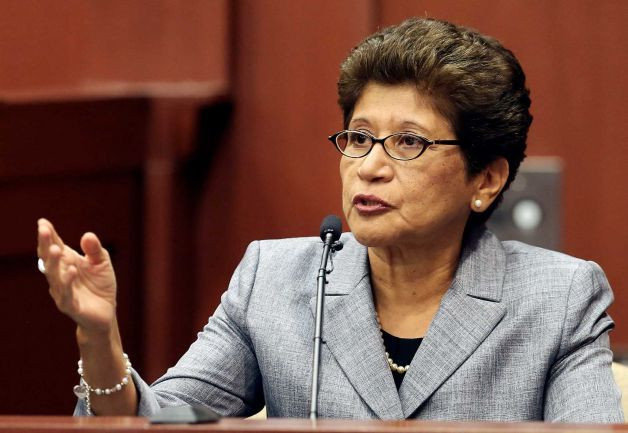
As protests mount against the verdict in the trial of George Zimmerman, the question of how the public ought to see Zimmerman's racial background continues to provoke. Many continue to view him as "white," as he was described in initial reports. Others have turned to "white Hispanic." But in a September 2012 interview on Univision with Jorge Ramos, Zimmerman's brother Robert spoke out against media characterizations of George as "white," while George's mother Gladys said she came from a family that was proud of its Afro-Peruvian roots.
On robertandgladys.com, a website started by George Zimmerman's parents in support of their son, his father Robert, a white American of German descent, writes that his wife was born in the capital of Lima and that after she graduated from college, she became a physical education teacher.
"However, during a trip to visit her brother, a soldier stationed in the Military District of Washington, we were introduced...on December 20, 1975 we were married in a traditional, Catholic wedding," reads the site, which elsewhere takes pains to show the extent to which George and the Zimmerman family had warm relations with black neighbors and members of their Florida community.
In a 2012 letter to the Orlando Sentinel, the father also rebuked claims that his son's decisions on the night Trayvon Martin was killed were motivated by race, writing, "He would be the last to discriminate for any reason whatsoever...The media portrayal of George as a racist could not be further from the truth."
RELATED: 5 Fast Facts About Trayvon Martin
"In Peru we have a saying that goes, 'If you don't have the blood of the Incas, you've got the blood of the Mandingas," which means that if you don't have Indian blood, you've got black blood," Gladys Zimmerman said on Univision. "In my family we proudly come from the Afro-Peruvian race. My sons know their uncles, they know their aunts, they know their roots and my roots are not white, my roots are Afro-Peruvian. So they've been educated, not just at home as a family, at school. My sons don't look at color."
According to Tanya Golash-Boza, a sociologist at the University of California and the author of "Yo Soy Negro: Blackness in Peru," Gladys Zimmerman's description of herself as "Afro-Peruvian" is somewhat unusual.
"The word 'Afro-Peruvian' is kind of a new concept in Peru," she told the Latin Times. "The idea that some people are African-descendent, some people are indigenous-descendent, some people are Hispanic-descendent has some currency in Peru, but it hasn't really reached down to the level of popular sentiment. Instead, people tend to be identified as black if they have visible African ancestry. If people can look at them and make a guess that their ancestors probably came from Africa -- very curly hair, darker skin."
RELATED: Obama Urges 'Calm Reflection' As Protests Ramp Up Over Martin Case
In November 2009, Peru's government became the first in Latin America to apologize to its black population for centuries of abuse, exclusion and discrimination, and admitted that discrimination continues to occur up into the present day.
Golash-Boza says the term "Afro-Peruvian" remains one used in government and NGO circles, especially since the year 2000, when the World Bank funded a government research project on people of African descent in Peru. "In my research, which was in a community in northern Peru, people tended to identify as black. No one used the word 'Afro-Peruvian' in daily discourse. They were sort of aware of it, on the one hand through popular culture, and then because of the government initiatives. If you asked someone about Afro-Peruvian heritage or culture, they would know how to answer your question, but it doesn't seem to arise naturally in conversation."
RELATED: 4 Fast Facts About The Stand Your Ground Law
Like other countries in Latin America, Peru's government does not ask its citizens to identify their race on census surveys. As such, the number of Peruvians who might self-identify as "black" or "Afro-Peruvian" isn't known. A 2011 book from Henry Louis Gates, "Black in Latin America", puts it at somewhere between 600,000 and 3 million -- that is, from 2 to 10 percent of Peru's 30 million people. Gates notes in the book that a CIA fact book on Peru says the country's mestizo population is about 37 percent and argues that in the United States, much of that figure would be defined as "black."
And disparities in health, employment, and education are huge. For example, according to a documentary Gates made on the subject, only 27 percent of Afro-Peruvians finish high school, and 2 percent get a college education. This compared to the 78 percent and 32 percent of the general Peruvian population, respectively.
Golash-Boza notes that inequality is generally a problem in Peru. But she adds that one of the main stereotypes of blacks in Peru is of criminality, and cites a popular joke: Cuando ves a un blanco corriendo, está haciendo deporte. Cuando ves a un negro corriendo, es un ladrón. When you see a white man running, he's jogging. When you see a black man running, he's a thief.
"This came up in interviews. I would ask people, 'how would you feel if your daughter married a black man?' Some people would say, 'As long as he's not a criminal, it's fine.'"
© 2025 Latin Times. All rights reserved. Do not reproduce without permission.



